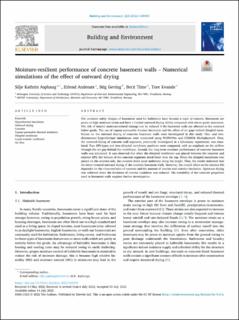| dc.contributor.author | Asphaug, Silje Kathrin | |
| dc.contributor.author | Andenæs, Erlend | |
| dc.contributor.author | Geving, Stig | |
| dc.contributor.author | Time, Berit | |
| dc.contributor.author | Kvande, Tore | |
| dc.date.accessioned | 2022-11-17T07:13:18Z | |
| dc.date.available | 2022-11-17T07:13:18Z | |
| dc.date.created | 2022-08-01T10:20:08Z | |
| dc.date.issued | 2022 | |
| dc.identifier.issn | 0360-1323 | |
| dc.identifier.uri | https://hdl.handle.net/11250/3032279 | |
| dc.description.abstract | The moisture safety designs of basements used for habitation have become a topic of concern. Basements are prone to high moisture strain and have a limited outward drying ability compared with above-grade structures. The risk of interior moisture-related damage can be reduced if the basement walls are allowed to dry outward below grade. The use of vapour-permeable thermal insulation and the effect of air gaps behind dimpled membranes on the outward drying of concrete basement walls were investigated in this study. One- and two-dimensional hygrothermal simulations were conducted using WUFI®Pro and COMSOL Multiphysics®. First, the outward drying of concrete wall segments, previously investigated in a laboratory experiment, was simulated. Two EPS types and two dimpled membrane positions were compared, with an emphasis on the airflow through the air gap behind the membrane. Second, the long-term moisture performance of concrete basement walls was simulated. It was observed that when the dimpled membrane was placed between the concrete and exterior EPS, the bottom of the concrete segments dried faster than the top. When the dimpled membrane was placed on the exterior side, the concrete dried more uniformly along the height. Thus, the results indicated that the latter ensured outward drying of the concrete basement walls. However, the overall effect on the interior RH depended on the characteristics of concrete and the amount of interior and exterior insulation. Optimum drying was achieved when the thickness of interior insulation was reduced. The variability of the concrete properties used in basement walls requires further investigation. | en_US |
| dc.language.iso | eng | en_US |
| dc.publisher | Elsevier | en_US |
| dc.rights | CC BY 4.0 | * |
| dc.rights.uri | http://creativecommons.org/licenses/by/4.0/ | * |
| dc.subject | Hygrothermal simulation | en_US |
| dc.subject | Outward drying | en_US |
| dc.subject | Concrete | en_US |
| dc.subject | Vapour-permeable thermal insulation | en_US |
| dc.subject | Dimpled membrane | en_US |
| dc.subject | Liquid transfer coefficient | en_US |
| dc.subject | Air flow | en_US |
| dc.title | Moisture-resilient performance of concrete basement walls – Numerical simulations of the effect of outward drying | en_US |
| dc.title.alternative | Moisture-resilient performance of concrete basement walls – Numerical simulations of the effect of outward drying | en_US |
| dc.type | Peer reviewed | en_US |
| dc.type | Journal article | en_US |
| dc.description.version | publishedVersion | en_US |
| dc.rights.holder | © 2022 The authors | en_US |
| dc.subject.nsi | VDP::Teknologi: 500 | en_US |
| dc.source.volume | 222 | en_US |
| dc.source.journal | Building and Environment | en_US |
| dc.identifier.doi | 10.1016/j.buildenv.2022.109393 | |
| dc.identifier.cristin | 2040260 | |
| dc.relation.project | Norges forskningsråd: 237859 | en_US |
| dc.source.articlenumber | 109393 | en_US |
| cristin.ispublished | true | |
| cristin.fulltext | original | |
| cristin.qualitycode | 2 | |

